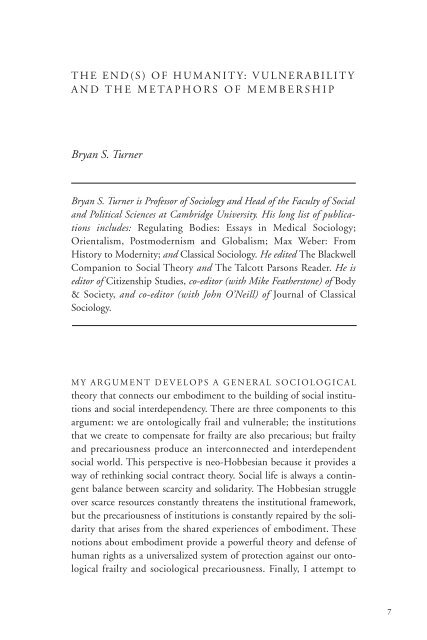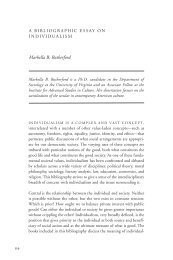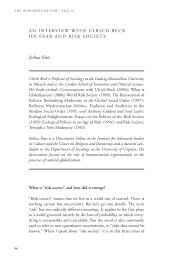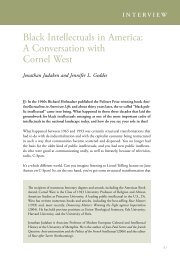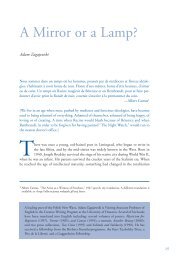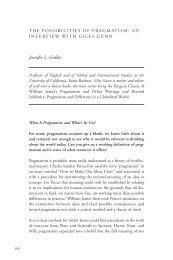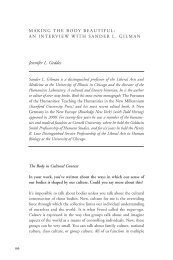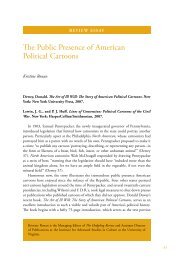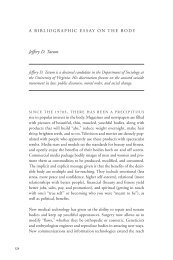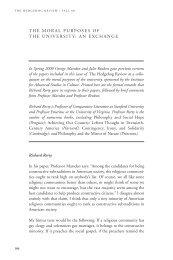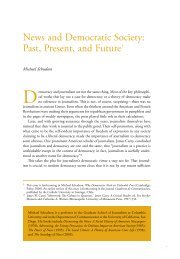The End(s) of Humanity - Institute for Advanced Studies in Culture
The End(s) of Humanity - Institute for Advanced Studies in Culture
The End(s) of Humanity - Institute for Advanced Studies in Culture
Create successful ePaper yourself
Turn your PDF publications into a flip-book with our unique Google optimized e-Paper software.
THE END(S) OF HUMANITY: VULNERABILITY<br />
AND THE METAPHORS OF MEMBERSHIP<br />
Bryan S. Turner<br />
Bryan S. Turner is Pr<strong>of</strong>essor <strong>of</strong> Sociology and Head <strong>of</strong> the Faculty <strong>of</strong> Social<br />
and Political Sciences at Cambridge University. His long list <strong>of</strong> publications<br />
<strong>in</strong>cludes: Regulat<strong>in</strong>g Bodies: Essays <strong>in</strong> Medical Sociology;<br />
Orientalism, Postmodernism and Globalism; Max Weber: From<br />
History to Modernity; and Classical Sociology. He edited <strong>The</strong> Blackwell<br />
Companion to Social <strong>The</strong>ory and <strong>The</strong> Talcott Parsons Reader. He is<br />
editor <strong>of</strong> Citizenship <strong>Studies</strong>, co-editor (with Mike Featherstone) <strong>of</strong> Body<br />
& Society, and co-editor (with John O’Neill) <strong>of</strong> Journal <strong>of</strong> Classical<br />
Sociology.<br />
MY ARGUMENT DEVELOPS A GENERAL SOCIOLOGICAL<br />
theory that connects our embodiment to the build<strong>in</strong>g <strong>of</strong> social <strong>in</strong>stitutions<br />
and social <strong>in</strong>terdependency. <strong>The</strong>re are three components to this<br />
argument: we are ontologically frail and vulnerable; the <strong>in</strong>stitutions<br />
that we create to compensate <strong>for</strong> frailty are also precarious; but frailty<br />
and precariousness produce an <strong>in</strong>terconnected and <strong>in</strong>terdependent<br />
social world. This perspective is neo-Hobbesian because it provides a<br />
way <strong>of</strong> reth<strong>in</strong>k<strong>in</strong>g social contract theory. Social life is always a cont<strong>in</strong>gent<br />
balance between scarcity and solidarity. <strong>The</strong> Hobbesian struggle<br />
over scarce resources constantly threatens the <strong>in</strong>stitutional framework,<br />
but the precariousness <strong>of</strong> <strong>in</strong>stitutions is constantly repaired by the solidarity<br />
that arises from the shared experiences <strong>of</strong> embodiment. <strong>The</strong>se<br />
notions about embodiment provide a powerful theory and defense <strong>of</strong><br />
human rights as a universalized system <strong>of</strong> protection aga<strong>in</strong>st our ontological<br />
frailty and sociological precariousness. F<strong>in</strong>ally, I attempt to<br />
7
THE HEDGEHOG REVIEW / SUMMER 01<br />
reflect on the erosion <strong>of</strong> bodily metaphors <strong>in</strong> contemporary society as<br />
an <strong>in</strong>dex <strong>of</strong> the alienation <strong>of</strong> our embodiment <strong>in</strong> technological society,<br />
where social life is disrupted by risk and regulation. In the archaic<br />
world, embodiment is a source <strong>of</strong> b<strong>in</strong>d<strong>in</strong>g metaphors <strong>of</strong> sociality, but<br />
these have been progressively underm<strong>in</strong>ed by technological change.<br />
<strong>The</strong> exhaustion <strong>of</strong> metaphors provides no opportunity <strong>for</strong> adequately<br />
grasp<strong>in</strong>g the dialectic <strong>of</strong> risk and regulation with<strong>in</strong> a common language<br />
<strong>of</strong> responsibility.<br />
My proposal is that the concept <strong>of</strong> embodiment must be placed at the<br />
core <strong>of</strong> any adequate picture <strong>of</strong> social life. A renewal <strong>of</strong> critical sociology<br />
depends on a theoretical <strong>in</strong>tegration <strong>of</strong> the connections between the<br />
vulnerability <strong>of</strong> human embodiment and the precarious nature <strong>of</strong> social<br />
<strong>in</strong>stitutions. <strong>The</strong> richness <strong>of</strong> metaphors <strong>of</strong> embodiment is never very<br />
far from an effective conceptualization <strong>of</strong> <strong>in</strong>stitutions. <strong>The</strong> fact that the<br />
body is important to the metaphors we use to th<strong>in</strong>k with has been commonly<br />
recognized <strong>in</strong> social anthropology.<br />
Consider religious mythology. Because the body is traditionally always<br />
the nearest-to-hand source <strong>of</strong> metaphors <strong>for</strong> understand<strong>in</strong>g society, it is<br />
hardly surpris<strong>in</strong>g that the Abrahamic faiths are constructed around<br />
body metaphors. In the Christian faith, <strong>for</strong> example, these metaphors<br />
<strong>in</strong>clude: virg<strong>in</strong> births, charisma as blood, Adam’s Rib, Mary’s milk <strong>of</strong><br />
sustenance, the Sacred Heart, and the Eucharistic Feast. It is also the<br />
case that basic social theories have also been corporeal. Feasts provided<br />
an elementary model <strong>of</strong> society, and the Church was conceptualized as<br />
a body. From the idea <strong>of</strong> the Church as the Body <strong>of</strong> Christ came early<br />
models <strong>of</strong> trad<strong>in</strong>g groups as corporations. <strong>The</strong> body is, however, more<br />
than a rich source <strong>of</strong> metaphor. It is constitutive <strong>of</strong> our be<strong>in</strong>g-<strong>in</strong>-theworld,<br />
but <strong>in</strong> contemporary societies the dom<strong>in</strong>ance <strong>of</strong> biotechnology<br />
has brought about an erosion <strong>of</strong> a sense <strong>of</strong> common ontology.<br />
My attempt to renew sociological theory is based on three assumptions:<br />
the vulnerability <strong>of</strong> embodiment, the precariousness <strong>of</strong> <strong>in</strong>stitutions,<br />
and the <strong>in</strong>terconnectedness <strong>of</strong> social life. <strong>The</strong>re is a dialectical relationship<br />
between these three components that becomes obvious when one<br />
th<strong>in</strong>ks about the process <strong>of</strong> modernization. It is with<strong>in</strong> this dialectical<br />
balance between frailty, precariousness, and <strong>in</strong>terconnectedness that<br />
8
THE END(S) OF HUMANITY / TURNER<br />
modern medical technologies are powerful and far-reach<strong>in</strong>g. If our<br />
embodiment is the real source <strong>of</strong> common sociability, then changes to<br />
our embodiment must have implications <strong>for</strong> vulnerability and <strong>in</strong>terconnectedness.<br />
<strong>The</strong> new micro-biological revolution is Cartesian (<strong>in</strong> re<strong>in</strong><strong>for</strong>c<strong>in</strong>g the<br />
separation <strong>of</strong> m<strong>in</strong>d and body); it is driven by a powerful commercial<br />
logic, and has (largely unrecognized) military and polic<strong>in</strong>g uses and<br />
implications that are problematic <strong>for</strong> human rights and political democracy.<br />
Contemporary medic<strong>in</strong>e has promoted a “mirage <strong>of</strong> health,” 1 but<br />
clon<strong>in</strong>g, reproductive technology, and organ transplants both express<br />
and enhance social <strong>in</strong>equalities, especially between societies, and they<br />
have the potential to trans<strong>for</strong>m our human identity <strong>in</strong> ways that are<br />
negative and destructive. <strong>The</strong> po<strong>in</strong>t <strong>of</strong> this paper is to raise once more<br />
the ambiguity <strong>of</strong> the questions: what are the proper goals (ends) <strong>of</strong> a<br />
political community, and do our current problems anticipate the term<strong>in</strong>ation<br />
(end) <strong>of</strong> the human? Is this crisis the end <strong>of</strong> humanity (as an<br />
empirical community <strong>of</strong> be<strong>in</strong>gs) or the end <strong>of</strong> the human (as the possibility<br />
<strong>of</strong> a conceptual category)? 2<br />
Let us reconsider religious mythology. Religio is that which b<strong>in</strong>ds and<br />
discipl<strong>in</strong>es a community whose humanity is a function <strong>of</strong> a shared set<br />
<strong>of</strong> experiences <strong>of</strong> birth, maturation, procreation, and death. It is difficult<br />
to see how this communitas could survive the medical rationalization<br />
<strong>of</strong> our world or how anyth<strong>in</strong>g could replace or stand <strong>in</strong> <strong>for</strong> this<br />
religio. This loss is one sense <strong>in</strong> which we can speak <strong>of</strong> “the end <strong>of</strong> the<br />
human.” <strong>The</strong> twentieth-century philosopher who perhaps saw this crisis<br />
<strong>of</strong> be<strong>in</strong>g most clearly was Mart<strong>in</strong> Heidegger, who believed that modern<br />
technology, as an exploitative framework <strong>of</strong> natural resources,<br />
would <strong>in</strong>terpose itself between be<strong>in</strong>g and the world. 3<br />
1 René Dubois, <strong>The</strong> Mirage <strong>of</strong> Health: Utopias, Progress, and Biological Change<br />
(London: Allen & Unw<strong>in</strong>, 1960).<br />
2 This paper grows, <strong>in</strong> part, out <strong>of</strong> reflections on the erasure <strong>of</strong> man at “the edge <strong>of</strong> the<br />
sea” <strong>in</strong> Michel Foucault’s <strong>The</strong> Order <strong>of</strong> Th<strong>in</strong>gs (London: Tavistock, 1970) 387.<br />
3 Mart<strong>in</strong> Heidegger, <strong>The</strong> Question Concern<strong>in</strong>g Technology and Other Essays (New York:<br />
Harper & Row, 1977).<br />
9
THE HEDGEHOG REVIEW / SUMMER 01<br />
Embodiment, Vulnerability, and Frailty<br />
Human be<strong>in</strong>gs are ontologically frail and their natural environment<br />
uncerta<strong>in</strong>. In order to protect themselves from vagaries and afflictions,<br />
they must build social <strong>in</strong>stitutions (especially political, familial, and<br />
ecclesiastical <strong>in</strong>stitutions) that come to constitute what we call “society.”<br />
We need the companionship <strong>of</strong> society that, through the shar<strong>in</strong>g<br />
<strong>of</strong> bread (pan), provides us with means <strong>of</strong> mutual support. We need the<br />
creative <strong>for</strong>ce <strong>of</strong> ritual and the emotional effervescence <strong>of</strong> common festivals<br />
to renew social life and to build effective <strong>in</strong>stitutions, and we<br />
need the com<strong>for</strong>ts <strong>of</strong> social <strong>in</strong>stitutions as means <strong>of</strong> <strong>for</strong>tify<strong>in</strong>g our existence.<br />
<strong>The</strong>se <strong>in</strong>stitutions are, however, themselves precarious and cannot<br />
provide an adequate and reliable social environment. Rituals <strong>of</strong>ten<br />
go awry, as René Girard has argued <strong>in</strong> Violence and the Sacred. 4<br />
Fortunately, these afflictions and uncerta<strong>in</strong>ties generate <strong>in</strong>ter-societal<br />
patterns <strong>of</strong> dependency and connectedness that <strong>in</strong> their more psychological<br />
manifestations result <strong>in</strong> sympathy and empathy without which<br />
society would not be possible. We can summarize this argument by say<strong>in</strong>g<br />
that all social existence is characterized by the contradictory relationships<br />
between scarcity and solidarity. This picture <strong>of</strong> society is<br />
neo-Hobbesian. Its premise is that life is nasty, brutish, and short, but,<br />
<strong>in</strong>stead <strong>of</strong> the <strong>in</strong>dividualistic notion <strong>of</strong> a social contract, human and<br />
social rights are juridical expressions <strong>of</strong> basic patterns <strong>of</strong> solidarity<br />
whose foundations are <strong>in</strong> the common experience <strong>of</strong> frailty and precariousness,<br />
on the one hand, and social <strong>in</strong>terconnectedness, on the other.<br />
My argument clearly has some connections with Alasdair MacIntyre’s<br />
Dependent Rational Animals, <strong>in</strong> which he criticizes Western philosophy<br />
<strong>for</strong> its neglect <strong>of</strong> two central facts about human be<strong>in</strong>gs—their vulnerability<br />
and their afflictions. 5 He goes on to argue that vulnerability<br />
expla<strong>in</strong>s our dependence on others <strong>for</strong> protection and sustenance.<br />
4 René Girard, Violence and the Sacred (London: Athlone, 1988).<br />
5 Alasdair C. MacIntyre, Dependent Rational Animals: Why Human Be<strong>in</strong>gs Need the<br />
Virtues (Chicago: Open Court, 1999).<br />
10
THE END(S) OF HUMANITY / TURNER<br />
Vulnerability is derived <strong>in</strong>tellectually from the legacy <strong>of</strong> Aristotle’s view<br />
<strong>of</strong> animality. Although MacIntyre’s notion <strong>of</strong> vulnerability is compatible<br />
with my project, there are some important differences between the<br />
two arguments. My own approach is part <strong>of</strong> a legacy <strong>of</strong> sociological<br />
analysis that <strong>in</strong>cludes admittedly very diverse and divergent figures:<br />
Marx, Lowith, Gehlen, Berger and Luckmann, rather than Aristotle<br />
and Aqu<strong>in</strong>as. While MacIntyre quotes Maurice Merleau-Ponty with<br />
some approval to suggest that “I am my body,” 6 my approach is concerned<br />
to explore “embodiment” as a process rather than “body” as a<br />
fixed phenomenon. <strong>The</strong> vulnerability <strong>of</strong> embodiment is connected <strong>in</strong><br />
my account with a view <strong>of</strong> the precarious nature <strong>of</strong> <strong>in</strong>stitutions and the<br />
<strong>in</strong>terconnected nature <strong>of</strong> the social world. A sociological understand<strong>in</strong>g<br />
<strong>of</strong> the social world needs to grasp two processes: embodiment and <strong>in</strong>stitutionalization.<br />
<strong>The</strong> po<strong>in</strong>t is to develop a general sociology <strong>of</strong> everyday<br />
life based on embodiment, <strong>in</strong>stitutions, and social networks that <strong>in</strong><br />
turn lays the foundation <strong>for</strong> a justification <strong>of</strong> human rights that are<br />
<strong>in</strong>stitutional manifestations <strong>of</strong> our (global) dependency. This discussion<br />
<strong>of</strong> vulnerability and rights has to be located with<strong>in</strong> a global social system,<br />
where the hybridity and fragmentation <strong>of</strong> culture br<strong>in</strong>gs <strong>in</strong>to question<br />
our ability to susta<strong>in</strong> solidarity.<br />
<strong>The</strong> concept <strong>of</strong> vulnerability is derived from the Lat<strong>in</strong> vulnus or<br />
“wound.” It is <strong>in</strong>structive from my perspective that “vulnerability”<br />
should have such an obviously corporeal orig<strong>in</strong>. In the seventeenth century,<br />
vulnerability had both a passive and active significance, namely to<br />
be wounded and to wound. In mediaeval religious practice, veneration<br />
<strong>of</strong> the Passion was associated with meditation on the Seven Wounds <strong>of</strong><br />
Christ. <strong>The</strong>se wounds were evidence <strong>of</strong> the humanity and suffer<strong>in</strong>g <strong>of</strong><br />
Christ, and these human attributes came to emphasize his vulnerability.<br />
7 <strong>The</strong>se themes <strong>of</strong> Christ’s suffer<strong>in</strong>g evolved eventually <strong>in</strong>to the cult<br />
<strong>of</strong> the Sacred Heart. In its active sense, to vulnerate is to wound, but <strong>in</strong><br />
6 MacIntyre 6.<br />
7 Rosemary Woolf, <strong>The</strong> English Religious Lyric <strong>in</strong> the Middle Ages (Ox<strong>for</strong>d: Clarendon,<br />
1968) 221.<br />
11
THE HEDGEHOG REVIEW / SUMMER 01<br />
its modern usage it has come to signify the human capacity to be open<br />
to wounds. Vulnerability has become, <strong>in</strong> one sense, more abstract: it<br />
refers to the human capacity to be exposed to psychological or moral<br />
damage. It refers <strong>in</strong>creas<strong>in</strong>gly to our ability to suffer (morally and spiritually)<br />
rather than to a physical capacity <strong>for</strong> pa<strong>in</strong> from our exposure or<br />
openness to the world. This openness to wound<strong>in</strong>g is part <strong>of</strong> what Peter<br />
Berger has called our “world openness,” namely that we do not live <strong>in</strong> a<br />
biologically determ<strong>in</strong>ed or species-specific environment. 8 To be vulnerable<br />
as a human be<strong>in</strong>g is to possess a structure <strong>of</strong> sentiments, feel<strong>in</strong>gs,<br />
and emotions by which we can steer a passage through the social order.<br />
Our vulnerability is also part <strong>of</strong> our capacity to draw sensual pleasures<br />
from our openness to experiences. <strong>The</strong>re<strong>for</strong>e, Marx rather than Aristotle<br />
<strong>of</strong>fers a more promis<strong>in</strong>g start<strong>in</strong>g po<strong>in</strong>t <strong>for</strong> a study <strong>of</strong> our wound<strong>in</strong>g,<br />
because he po<strong>in</strong>ts to the sensual, practical, and active components <strong>of</strong><br />
the structure <strong>of</strong> social action. In one sense we need to be vulnerable <strong>in</strong><br />
order to be open to threats and dangers so that we may take evasive<br />
action. MacIntyre’s position, which has a one-dimensional emphasis on<br />
disability and affliction, is ultimately limited because it presents a somewhat<br />
passive view <strong>of</strong> vulnerability. It is important to avoid a melancholic<br />
social science, 9 but it is equally important to recognize the social<br />
worlds that human be<strong>in</strong>gs fashion collectively are <strong>in</strong>herently and alarm<strong>in</strong>gly<br />
precarious.<br />
In order to provide some conceptual depth to this model <strong>of</strong> frailty and<br />
precariousness, it is necessary to develop a sociology <strong>of</strong> the body, and <strong>in</strong><br />
particular a notion <strong>of</strong> embodiment as a framework <strong>for</strong> a theory <strong>of</strong> social<br />
action. Adopt<strong>in</strong>g the notion <strong>of</strong> the social as process, it is important not<br />
to reify “the body,” but to treat embodiment as a process, namely the<br />
social processes <strong>of</strong> embody<strong>in</strong>g. First, embodiment is the effect or consequence<br />
<strong>of</strong> ongo<strong>in</strong>g practices <strong>of</strong> corporalization. In this respect,<br />
8 Peter L. Berger, Man <strong>in</strong> the Age <strong>of</strong> Technology (New York: Columbia University Press,<br />
1980).<br />
9 Wolf Lepenies, Melancholy and Society, trans. Jeremy Ga<strong>in</strong>es and Doris Jones<br />
(Cambridge, MA: Harvard University Press, 1992).<br />
12
THE END(S) OF HUMANITY / TURNER<br />
embodiment is a life process that requires the learn<strong>in</strong>g <strong>of</strong> body techniques—walk<strong>in</strong>g,<br />
sitt<strong>in</strong>g, danc<strong>in</strong>g, and eat<strong>in</strong>g. Embodiment is the<br />
ensemble <strong>of</strong> corporeal practices that produces and gives “a body” its<br />
place <strong>in</strong> everyday life. Embodiment places particular bodies with<strong>in</strong> a<br />
social habitus.<br />
Secondly, embodiment requires the production <strong>of</strong> a sensuous and practical<br />
presence <strong>in</strong> the life world. Embodiment is the lived experience <strong>of</strong><br />
the sensual or subjective body and it is, <strong>in</strong> this sense, consistent with<br />
Marx’s discussion <strong>of</strong> practice <strong>in</strong> the Paris Manuscripts and with Pierre<br />
Bourdieu’s notions <strong>of</strong> practice and habitus. 10 Practice <strong>in</strong>volves the sensual,<br />
live body and its effects on social relations. It is the active shap<strong>in</strong>g<br />
<strong>of</strong> the lived world by embodied practices.<br />
Thirdly, embodiment is a collective project because it takes place <strong>in</strong> a<br />
life world that is already social. Embodiment is not an isolated project<br />
<strong>of</strong> the <strong>in</strong>dividual; it is located with<strong>in</strong> a social world <strong>of</strong> <strong>in</strong>terconnected<br />
social actors.<br />
F<strong>in</strong>ally, while it is the process <strong>of</strong> mak<strong>in</strong>g and becom<strong>in</strong>g a body, it is also<br />
the project <strong>of</strong> mak<strong>in</strong>g a self. Embodiment and enselfment are mutually<br />
dependent and re<strong>in</strong><strong>for</strong>c<strong>in</strong>g processes. <strong>The</strong> self <strong>in</strong>volves a corporeal project<br />
with<strong>in</strong> a specific social nexus where the cont<strong>in</strong>uous self depends on<br />
successful embodiment, a social habitus, and memory. Follow<strong>in</strong>g both<br />
Marx and Bourdieu, embodiment and enselfment always take place <strong>in</strong><br />
specific spatial contexts, and habitus must be a set <strong>of</strong> practices <strong>in</strong> a particular<br />
location; it must, we might say, secure emplacement. Thus, the<br />
sociological notion <strong>of</strong> a “body” <strong>in</strong>volves three related processes: embodiment,<br />
enselfment, and emplacement.<br />
Because embodiment has <strong>in</strong> fact many dimensions, one can talk about<br />
hav<strong>in</strong>g a body <strong>in</strong> which the body has the characteristics <strong>of</strong> a th<strong>in</strong>g,<br />
be<strong>in</strong>g a body <strong>in</strong> which we are subjectively engaged with our body as a<br />
10 Pierre Bourdieu, <strong>The</strong> Logic <strong>of</strong> Practice (Cambridge: Polity, 1990).<br />
13
THE HEDGEHOG REVIEW / SUMMER 01<br />
project, and do<strong>in</strong>g a body <strong>in</strong> the sense <strong>of</strong> produc<strong>in</strong>g a body through<br />
time. 11 <strong>The</strong>se dist<strong>in</strong>ctions are more felicitously expressed <strong>in</strong> German<br />
where there is a ready-made dist<strong>in</strong>ction between the body as an object<br />
(Koerper) and the body as lived experience (Leib). <strong>The</strong> body is simultaneously<br />
an object that I can observe and a mode <strong>of</strong> be<strong>in</strong>g that makes<br />
that observation possible. <strong>The</strong> relationship <strong>of</strong> <strong>in</strong>dividuals to their own<br />
bodies is never an external, objective, or neutral relationship, because<br />
identity is <strong>in</strong>extricably bound up with subjective be<strong>in</strong>g <strong>in</strong> the material<br />
world.<br />
This <strong>in</strong>timacy between our bodies, our everyday experiences, and our<br />
psychology was clearly expressed <strong>in</strong> Merleau-Ponty’s Phenomenology <strong>of</strong><br />
Perception. 12 His basic question was about how we experience reality;<br />
to experience the world, we have to perceive it and to perceive it we<br />
have to possess language. <strong>The</strong> embodiment <strong>of</strong> the human be<strong>in</strong>g is fundamental<br />
to these processes <strong>of</strong> the apprehension and perception <strong>of</strong><br />
immediate reality. <strong>The</strong> psychology <strong>of</strong> perception had ignored the fact<br />
that the <strong>in</strong>dividual’s perception <strong>of</strong> external reality <strong>in</strong>volved bodily experiences<br />
<strong>of</strong> the physical world, and a capacity to manipulate the everyday<br />
world through the motor activities <strong>of</strong> the body. <strong>The</strong>se capacities<br />
can be manifest verbally, auditorily, or visually. Language is necessarily<br />
embodied <strong>in</strong> these material <strong>for</strong>ms <strong>of</strong> the body’s potentiality. As a result,<br />
he rejected Cartesian m<strong>in</strong>d/body dualism to argue that th<strong>in</strong>k<strong>in</strong>g, do<strong>in</strong>g,<br />
and feel<strong>in</strong>g are practical activities that require our embodied presence.<br />
Ontological frailty <strong>in</strong>cludes the notion that human be<strong>in</strong>gs <strong>of</strong> necessity<br />
have a propensity to disease and sickness. <strong>The</strong>y are be<strong>in</strong>gs unto death,<br />
and their ag<strong>in</strong>g bodies create a tension between the body as lived experience<br />
and the objective body, which, through the life cycle, <strong>in</strong>volves us<br />
<strong>in</strong> existential discom<strong>for</strong>t. As a result <strong>of</strong> these conditions, human be<strong>in</strong>gs<br />
through the life process are <strong>in</strong>volved <strong>in</strong> various relationships <strong>of</strong> depen-<br />
11 Bryan S. Turner, <strong>The</strong> Body and Society (London: Sage, 1996).<br />
12 Maurice Merleau-Ponty, <strong>The</strong> Phenomenology <strong>of</strong> Perception (London: Routledge &<br />
Kegan Paul, 1962).<br />
14
THE END(S) OF HUMANITY / TURNER<br />
dency. We are, <strong>in</strong> the language <strong>of</strong> Nietzsche, the unf<strong>in</strong>ished animal.<br />
<strong>The</strong> notion <strong>of</strong> the <strong>in</strong>completeness <strong>of</strong> human be<strong>in</strong>gs and their frailty<br />
was explored <strong>in</strong> the philosophical anthropology <strong>of</strong> Gehlen. 13 A theory<br />
<strong>of</strong> <strong>in</strong>stitutions lay at the core <strong>of</strong> his work. Human be<strong>in</strong>gs need to build<br />
rites (<strong>in</strong>stitutions), <strong>in</strong>clud<strong>in</strong>g a system <strong>of</strong> protective rights. Human<br />
be<strong>in</strong>gs are characterized by their “<strong>in</strong>st<strong>in</strong>ctual deprivation,” and there<strong>for</strong>e<br />
humans do not have a stable structure with<strong>in</strong> which to operate.<br />
Humans are def<strong>in</strong>ed by their “world openness,” because they are not<br />
equipped <strong>in</strong>st<strong>in</strong>ctively <strong>for</strong> a specific environment, and as a result they<br />
have to build or construct their own environment, a construction that<br />
requires the build<strong>in</strong>g <strong>of</strong> <strong>in</strong>stitutions. Social <strong>in</strong>stitutions are the bridges<br />
between humans and their physical environment, and it is through<br />
these <strong>in</strong>stitutions that human life becomes coherent, mean<strong>in</strong>gful, and<br />
cont<strong>in</strong>uous. 14 In fill<strong>in</strong>g the gap created by <strong>in</strong>st<strong>in</strong>ctual deprivation, <strong>in</strong>stitutions<br />
provide humans with relief from the tensions generated by<br />
undirected <strong>in</strong>st<strong>in</strong>ctual drives.<br />
Over time, these <strong>in</strong>stitutions are taken <strong>for</strong> granted and become part <strong>of</strong><br />
the background <strong>of</strong> social action. <strong>The</strong> <strong>for</strong>eground is occupied by reflexive,<br />
practical, and conscious activities. With modernization, there is a<br />
process <strong>of</strong> de-<strong>in</strong>stitutionalization with the result that the background<br />
becomes less reliable, more open to negotiation, culturally th<strong>in</strong>ner, and<br />
<strong>in</strong>creas<strong>in</strong>gly an object <strong>of</strong> reflection. Accord<strong>in</strong>gly the <strong>for</strong>eground<br />
expands, and life is seen to be risky and reflexive. <strong>The</strong> objective and<br />
sacred <strong>in</strong>stitutions <strong>of</strong> the past recede, and modern life becomes subjective,<br />
cont<strong>in</strong>gent, and uncerta<strong>in</strong>. In fact we live <strong>in</strong> a world <strong>of</strong> secondary<br />
or quasi-<strong>in</strong>stitutions. <strong>The</strong>re are pr<strong>of</strong>ound psychological consequences<br />
associated with these changes. Human be<strong>in</strong>gs <strong>in</strong> archaic societies had<br />
character, that is, a firm and def<strong>in</strong>ite psychological structure that corresponded<br />
with reliable background <strong>in</strong>stitutions. In modern societies, the<br />
13 Arnold Gehlen, Man, His Nature and Place <strong>in</strong> the World, trans. Clare McMillan and<br />
Karl Pillemer (New York: Columbia University Press, 1988).<br />
14 Peter L. Berger, and H. Kellner, “Arnold Gehlen and the <strong>The</strong>ory <strong>of</strong> Institutions,”<br />
Social Research 32.1 (1965): 110-15.<br />
15
THE HEDGEHOG REVIEW / SUMMER 01<br />
<strong>in</strong>dividual as personality is <strong>in</strong> a “lonely crowd” 15 and thus people have<br />
personalities that are fluid and flexible, like the <strong>in</strong>stitutions <strong>in</strong> which<br />
they live. We can argue <strong>in</strong> these terms that the modernization <strong>of</strong> cultures<br />
<strong>in</strong>volves a “<strong>for</strong>eground<strong>in</strong>g” <strong>of</strong> cultural practices and <strong>in</strong>stitutions<br />
that can no longer be taken <strong>for</strong> granted. In recent years, the medical<br />
revolution, which has been an effect <strong>of</strong> the trans<strong>for</strong>mation <strong>of</strong> the biological<br />
sciences, <strong>in</strong>volves a <strong>for</strong>eground<strong>in</strong>g <strong>of</strong> <strong>in</strong>stitutions. In fact, this<br />
de-<strong>in</strong>stitutionalization <strong>of</strong> social life has nowhere been more significant<br />
than <strong>in</strong> sexual and reproductive relationships.<br />
<strong>The</strong> notion <strong>of</strong> social and political precariousness <strong>in</strong>cludes the <strong>in</strong>ability<br />
<strong>of</strong> political <strong>in</strong>stitutions to protect and serve the <strong>in</strong>terests <strong>of</strong> <strong>in</strong>dividuals,<br />
the failure <strong>of</strong> social <strong>in</strong>stitutions to cope with social change, the <strong>in</strong>ability<br />
<strong>of</strong> social <strong>in</strong>stitutions to reconcile the conflict <strong>of</strong> collective and <strong>in</strong>dividual<br />
<strong>in</strong>terests, and f<strong>in</strong>ally the problems <strong>for</strong> society <strong>in</strong> terms <strong>of</strong> equity<br />
to cope with generational exchanges. Institutions have to be built up<br />
over time and <strong>of</strong>ten fail to respond quickly to social change. <strong>The</strong> process<br />
<strong>of</strong> <strong>in</strong>stitutionalization tends to be conservative and cannot address the<br />
chang<strong>in</strong>g aspirations <strong>of</strong> new generations. <strong>The</strong> trans<strong>for</strong>mations <strong>of</strong> charisma<br />
by rout<strong>in</strong>ization are a familiar aspect <strong>of</strong> traditional societies. In the<br />
modern economy, organizational failures, take-overs, mergers, corporate<br />
corruption, downsiz<strong>in</strong>g, organizational stress, <strong>in</strong>flation, currency<br />
<strong>in</strong>stability, and restructur<strong>in</strong>g are permanent features <strong>of</strong> the globalization<br />
<strong>of</strong> the bus<strong>in</strong>ess world. On a larger canvas, the collapse <strong>of</strong> the<br />
Communist regime as a consequence <strong>of</strong> the <strong>in</strong>ability <strong>of</strong> a rigid bureaucratic<br />
system and a privileged elite to respond to economic and social<br />
stra<strong>in</strong> has produced the global <strong>in</strong>stability <strong>of</strong> modern politics.<br />
Illustrations <strong>of</strong> <strong>in</strong>stitutional precariousness are relatively abundant: the<br />
<strong>in</strong>stability <strong>of</strong> global f<strong>in</strong>ancial markets, the exposure <strong>of</strong> human populations<br />
to global disease through such conditions as HIV and AIDS, the<br />
<strong>in</strong>stability <strong>of</strong> the natural environment through <strong>in</strong>dustrialization and<br />
pollution, and the <strong>in</strong>stability <strong>of</strong> orderly society through the globaliza-<br />
15 David Riesman, <strong>The</strong> Lonely Crowd. A Study <strong>of</strong> the Chang<strong>in</strong>g American Character<br />
(New Haven: Yale University Press, 1950).<br />
16
THE END(S) OF HUMANITY / TURNER<br />
tion <strong>of</strong> crime and narcotics. Contemporary complexity theory suggests<br />
that modern social systems cannot effectively resolve the complexities<br />
and cont<strong>in</strong>gencies <strong>of</strong> their environment, and hence precariousness is a<br />
function <strong>of</strong> modernization.<br />
Turn<strong>in</strong>g to the notion <strong>of</strong> <strong>in</strong>terconnectedness and <strong>in</strong>terdependence, this<br />
neo-Hobbesian world is not one <strong>of</strong> rampant <strong>in</strong>dividualism. While the<br />
argument from ontological frailty might suggest an <strong>in</strong>dividualist or<br />
even utilitarian paradigm, the notion <strong>of</strong> <strong>in</strong>terconnectedness <strong>in</strong>dicates<br />
that human be<strong>in</strong>gs are always and already social. <strong>The</strong>y are deeply<br />
<strong>in</strong>volved socially through language and socialization. <strong>The</strong> argument is<br />
that regardless <strong>of</strong> the cultural hybridity <strong>of</strong> urban life, we are still held<br />
together by a common ontology. However, this <strong>in</strong>terconnectedness is<br />
threatened by technological and medical change. <strong>The</strong> growth <strong>of</strong> cyborgs<br />
and other technologies may trans<strong>for</strong>m the nature <strong>of</strong> embodiment and<br />
remove this <strong>in</strong>terconnectedness <strong>of</strong> human life. This issue is the real<br />
importance <strong>of</strong> the question: Can there be a social world after the body<br />
where technology has trans<strong>for</strong>med the ethics <strong>of</strong> embodiment?<br />
<strong>The</strong> po<strong>in</strong>t <strong>of</strong> this <strong>for</strong>mulation <strong>of</strong> ontology is to provide a foundation<br />
<strong>for</strong> a sociological and normative defense <strong>of</strong> human rights as protective<br />
<strong>in</strong>stitutions. First there is the argument that the biological nature <strong>of</strong><br />
human frailty requires human rights as a protective canopy, and secondly<br />
there is the argument that social <strong>in</strong>stitutions are necessary but<br />
precarious. Given frailty and precariousness, human be<strong>in</strong>gs need a universalistic<br />
legal framework <strong>in</strong> which to seek legal protection. Both <strong>of</strong><br />
these arguments (frailty and precariousness) are an attempt to develop<br />
a contemporary version <strong>of</strong> Hobbes’s theory <strong>of</strong> the state without the<br />
limitations <strong>of</strong> a utilitarian notion <strong>of</strong> social contract. Hobbes argued <strong>in</strong><br />
Leviathan that rational human be<strong>in</strong>gs with conflict<strong>in</strong>g <strong>in</strong>terests <strong>in</strong> a<br />
state <strong>of</strong> nature would be <strong>in</strong> a condition <strong>of</strong> perpetual war. In order to<br />
protect themselves from mutual, endless slaughter, they create a state<br />
through a social contract, which organizes social space <strong>in</strong> the collective<br />
<strong>in</strong>terests <strong>of</strong> rational but antagonistic human be<strong>in</strong>gs. Furthermore, the<br />
<strong>in</strong>stitutions, which humans create as protective or defensive mechanisms,<br />
have to be sufficiently powerful to regulate social space and as a<br />
consequence come un<strong>in</strong>tentionally to present a threat to the human<br />
be<strong>in</strong>gs that <strong>in</strong>stitute the state through a social contract. For example,<br />
17
THE HEDGEHOG REVIEW / SUMMER 01<br />
the state, which holds a monopoly over legalized violence, is both a<br />
guarantor <strong>of</strong> social security but also an <strong>in</strong>strument necessarily <strong>of</strong> violence.<br />
Human be<strong>in</strong>gs are rational, but they are also embodied and they have a<br />
capacity <strong>for</strong> sympathy towards their fellow human be<strong>in</strong>gs. <strong>The</strong> capacity<br />
<strong>for</strong> suffer<strong>in</strong>g (another feature <strong>of</strong> vulnerability) is an important feature<br />
<strong>of</strong> membership <strong>of</strong> a moral community. <strong>The</strong> notion that sympathy is<br />
the social glue <strong>of</strong> a society characterized by precariousness can also be<br />
seen as a contemporary restatement <strong>of</strong> the theory <strong>of</strong> sentiments <strong>in</strong> classical<br />
political economy, especially a restatement <strong>of</strong> Humean social theory.<br />
16 <strong>The</strong> po<strong>in</strong>t <strong>of</strong> this sociological theory <strong>of</strong> rights is to provide a<br />
theoretical structure that will connect <strong>in</strong>dividual human rights as protective<br />
arrangements, the organization <strong>of</strong> the state as an <strong>in</strong>stitution that<br />
both guarantees rights but also threatens them, and the notion that<br />
sympathy is a major requirement <strong>of</strong> all social relations along with more<br />
traditional categories such as trust.<br />
Human Rights: Frailty, Precariousness, and Interconnectedness<br />
I have proposed the sociology <strong>of</strong> the body as a basis <strong>for</strong> defend<strong>in</strong>g a<br />
universalistic theory <strong>of</strong> human rights. 17 A full justification <strong>of</strong> this argument<br />
is beyond the scope <strong>of</strong> this paper, and there<strong>for</strong>e my aim is to <strong>in</strong>dicate<br />
what such a defense might entail. <strong>The</strong>re are clearly powerful<br />
arguments <strong>in</strong> favor <strong>of</strong> a relativist stand on rights discourse and thus a<br />
defense <strong>of</strong> rights aga<strong>in</strong>st a relativist consensus will need to be muscular.<br />
<strong>The</strong> notion <strong>of</strong> universal rights immediately runs <strong>in</strong>to at least two <strong>for</strong>midable<br />
obstacles. First, notions about universalism have been radically<br />
attacked by a variety <strong>of</strong> traditions <strong>in</strong> social philosophy with the result<br />
that there is a broad consensus that universalistic arguments are likely<br />
to be sociologically and anthropologically naive. For example, Max<br />
16 Richard Rorty, Cont<strong>in</strong>gency, Irony and Solidarity (Cambridge: Cambridge University<br />
Press, 1989).<br />
17 Bryan S. Turner, ed, Citizenship and Social <strong>The</strong>ory (London: Sage, 1993).<br />
18
THE END(S) OF HUMANITY / TURNER<br />
Weber’s sociology <strong>of</strong> law was an overt criticism <strong>of</strong> the idea that natural<br />
law could provide an authoritative and conv<strong>in</strong>c<strong>in</strong>g basis <strong>for</strong> rights. <strong>The</strong><br />
second obstacle is that the body <strong>in</strong> sociological theory is typically seen<br />
to be socially constructed and as such could not act as a general foundation<br />
<strong>for</strong> human rights. For example, Michel Foucault’s analysis <strong>of</strong> the<br />
human body was an attempt to show that the “body” was a cont<strong>in</strong>gent<br />
effect <strong>of</strong> power. In his Technologies <strong>of</strong> the Self, Foucault writes: “All <strong>of</strong><br />
my analyses are aga<strong>in</strong>st the idea <strong>of</strong> universal necessities <strong>in</strong> human existence.<br />
<strong>The</strong>y show the arbitrar<strong>in</strong>ess <strong>of</strong> <strong>in</strong>stitutions.” 18 In order to clear<br />
the ground <strong>for</strong> a discussion <strong>of</strong> human rights as an adjunct <strong>of</strong> the argument<br />
about embodiment, a detour is required to consider cultural relativism<br />
and social constructionism.<br />
Arguments about cultural relativism have been manipulated and abused<br />
by authoritarian governments to justify various <strong>for</strong>ms <strong>of</strong> state violence<br />
under the banner <strong>of</strong> cultural authenticity and difference. It is all too<br />
easy to justify abuses aga<strong>in</strong>st children and women, on the one hand, or<br />
devastation <strong>of</strong> the natural environment, on the other, by an appeal to<br />
local custom and traditions. Philosophical and sociological arguments<br />
aga<strong>in</strong>st relativism are there<strong>for</strong>e an important part <strong>of</strong> the political program<br />
to protect and defend human rights traditions <strong>in</strong> the public arena.<br />
<strong>The</strong> frailty <strong>of</strong> the human body and the precariousness <strong>of</strong> social life provide<br />
at least one possibility <strong>for</strong> start<strong>in</strong>g an account <strong>of</strong> a foundation <strong>for</strong><br />
human rights discourse. Because <strong>of</strong> this frailty and the precarious nature<br />
<strong>of</strong> social reality, human be<strong>in</strong>gs require the protective security <strong>of</strong> general<br />
human rights. Not all rights assume this <strong>for</strong>m <strong>of</strong> protective security but<br />
a large element <strong>of</strong> the human rights tradition is to provide some juridical<br />
security <strong>for</strong> human be<strong>in</strong>gs.<br />
Talk about human rights is <strong>of</strong>ten difficult <strong>in</strong> sociological and anthropological<br />
theory because <strong>of</strong> the prior commitment to the notion <strong>of</strong> cultural<br />
relativism. Because cultures differ fundamentally <strong>in</strong> their values,<br />
18 Michel Foucault, “Truth, Power, Self: An Interview with Michel Foucault,”<br />
Technologies <strong>of</strong> the Self: A Sem<strong>in</strong>ar with Michel Foucault, ed. Luther H. Mart<strong>in</strong>, Huck<br />
Gutman and Patrick H. Hutton (London: Tavistock, 1988) 11.<br />
19
THE HEDGEHOG REVIEW / SUMMER 01<br />
the notion <strong>of</strong> universal standards is difficult to defend <strong>in</strong>tellectually. In<br />
order to question this conventional view, I start my discussion by consider<strong>in</strong>g<br />
postmodern versions <strong>of</strong> anthropological relativism. My aim<br />
ultimately is to employ the sociology <strong>of</strong> the body as a strategy <strong>for</strong><br />
explor<strong>in</strong>g the moral basis <strong>of</strong> a universalistic doctr<strong>in</strong>e <strong>of</strong> human rights,<br />
but I fully recognize that universalism is an unpopular approach to<br />
social theory; it is <strong>of</strong>ten associated with claims about the privileged status<br />
<strong>of</strong> Western thought, or it is associated with patriarchal fantasies <strong>of</strong><br />
dom<strong>in</strong>ance. Universalistic claims about truth or justice have been challenged<br />
by various <strong>for</strong>ms <strong>of</strong> postmodernism and pragmatism, and the<br />
general mood <strong>of</strong> social science and the humanities has been more sympathetic<br />
to relativism and to the notion that “grand narratives” cannot<br />
be easily susta<strong>in</strong>ed. If the tone <strong>of</strong> universalism suggests a triumphalist<br />
attitude, contemporary thought has been generally anxious about bold<br />
claims to general, let alone universal, relevance and validity.<br />
It does not follow, however, that postmodernism has not been concerned<br />
with ethics. On the contrary, postmodernism, which has been<br />
<strong>in</strong>fluenced by Heidegger, has been specifically <strong>in</strong>terested <strong>in</strong> the idea <strong>of</strong><br />
“care” as an ethic that does not <strong>in</strong>volve grand claims about universalism.<br />
Follow<strong>in</strong>g Heidegger on <strong>for</strong>getfulness versus concern <strong>for</strong> otherness,<br />
we can detect a postmodern ethical stance <strong>in</strong> the idea <strong>of</strong> care <strong>for</strong><br />
marg<strong>in</strong>al or powerless groups, and concern <strong>for</strong> difference and otherness.<br />
Similarly, cruelty is, <strong>for</strong> Richard Rorty, the most serious crime,<br />
and cruelty <strong>in</strong> the <strong>for</strong>m <strong>of</strong> torture is a denial <strong>of</strong> humanity, <strong>in</strong>volv<strong>in</strong>g a<br />
<strong>for</strong>getfulness about the human status <strong>of</strong> victims. <strong>The</strong>se authors seek a<br />
ground<strong>in</strong>g <strong>for</strong> concern, not <strong>in</strong> the universal characteristics <strong>of</strong> human<br />
nature, but <strong>in</strong> the practical requirements <strong>for</strong> active care and affective<br />
sympathy. While such an approach has considerable merit, human<br />
frailty provides the basis <strong>for</strong> a universalistic ethic <strong>of</strong> concern that goes<br />
beyond the apparent complacency <strong>of</strong> contemporary relativism.<br />
<strong>The</strong> notion that the frailty <strong>of</strong> the body provides a foundation <strong>for</strong> rights<br />
is compatible with Heidegger’s account <strong>of</strong> the vulnerability <strong>of</strong> humans<br />
as be<strong>in</strong>gs that are bound to death through the <strong>in</strong>exorable passage <strong>of</strong><br />
time. Heidegger’s views on the “throwness” <strong>of</strong> be<strong>in</strong>g as a state which is<br />
permanently precarious provide an account <strong>of</strong> human frailty which is<br />
highly compatible with an emphasis on human frailty as a start<strong>in</strong>g po<strong>in</strong>t<br />
20
THE END(S) OF HUMANITY / TURNER<br />
<strong>for</strong> an analysis <strong>of</strong> rights. 19 <strong>The</strong> problem with relativism <strong>in</strong> political theory<br />
is, however, that it cannot simultaneously develop an ethic <strong>of</strong> care<br />
and satisfy questions about justice. <strong>The</strong> recognition <strong>of</strong> difference does<br />
not easily feed <strong>in</strong>to a theory that can give a good account <strong>of</strong> the conditions<br />
<strong>of</strong> justice. <strong>The</strong>re is there<strong>for</strong>e an ongo<strong>in</strong>g question about justice,<br />
namely the universality <strong>of</strong> the treatment <strong>of</strong> human be<strong>in</strong>gs as human<br />
be<strong>in</strong>gs.<br />
One <strong>of</strong> the perennial issues <strong>of</strong> modern social theory has been to identify<br />
a basis, however m<strong>in</strong>imalist, <strong>for</strong> some universalistic criterion <strong>of</strong> justice<br />
<strong>in</strong> relation to separate and particular social groups and<br />
communities. <strong>The</strong> core <strong>of</strong> this issue is to reconcile the aspiration <strong>for</strong><br />
political equality with the stubborn fact <strong>of</strong> social differences (<strong>in</strong> terms<br />
<strong>of</strong> class, ethnicity, and gender). Traditional accounts <strong>of</strong> the pr<strong>in</strong>ciple <strong>of</strong><br />
equality <strong>of</strong> opportunity have been appropriately challenged <strong>for</strong> example<br />
by postmodern fem<strong>in</strong>ism <strong>for</strong> their bl<strong>in</strong>dness to difference. However,<br />
if we regard justice as an issue about fairness, then there has to be some<br />
foundation <strong>of</strong> a universalistic character <strong>in</strong> order <strong>for</strong> such discussions<br />
about justice to take place. Some implicit commitment to universalism,<br />
typically as a residual category, is embraced by theorists who want overtly<br />
to adopt a resolutely antifoundationalist or contextualist position.<br />
Postmodern relativist epistemologies are <strong>of</strong>ten comb<strong>in</strong>ed with the<br />
implicit search <strong>for</strong> a common vocabulary with which to talk about politics<br />
and ethics. 20<br />
<strong>The</strong> conviction that embodiment is a fruitful plat<strong>for</strong>m <strong>for</strong> an argument<br />
<strong>in</strong> favor <strong>of</strong> the universalism <strong>of</strong> human rights via the notions <strong>of</strong> frailty<br />
and vulnerability is partly grounded <strong>in</strong> the notion <strong>of</strong> the ubiquity <strong>of</strong><br />
human misery. It is self-evidently true that, as Barr<strong>in</strong>gton Moore argues<br />
<strong>in</strong> Reflections on the Causes <strong>of</strong> Human Misery:<br />
suffer<strong>in</strong>g is not a value <strong>in</strong> its own right. In this sense any<br />
<strong>for</strong>m <strong>of</strong> suffer<strong>in</strong>g becomes a cost, and unnecessary suffer<strong>in</strong>g<br />
19 Mart<strong>in</strong> Heidegger, Be<strong>in</strong>g and Time (Ox<strong>for</strong>d: Basil Blackwell, 1962).<br />
20 Stephen K White, Political <strong>The</strong>ory and Postmodernism (Cambridge: Cambridge<br />
University Press, 1991).<br />
21
THE HEDGEHOG REVIEW / SUMMER 01<br />
an odious cost. Similarly, a general opposition to human<br />
suffer<strong>in</strong>g constitutes a stand-po<strong>in</strong>t that both transcends and<br />
unites different cultures and historical epochs. 21<br />
A critic might object that suffer<strong>in</strong>g is too variable <strong>in</strong> its manifestations<br />
to provide such a common standpo<strong>in</strong>t. What constitutes suffer<strong>in</strong>g <strong>in</strong><br />
practice might turn out to be culturally specific. Similar arguments<br />
have been made aga<strong>in</strong>st disability as a common standard. 22 One could<br />
accept this argument on the grounds that suffer<strong>in</strong>g <strong>in</strong>volves essentially<br />
the devaluation <strong>of</strong> a person as a consequence <strong>of</strong> accident, affliction, or<br />
torture, but pa<strong>in</strong> is less variable. Whereas bankruptcy could <strong>in</strong>volve<br />
some degree <strong>of</strong> psychological suffer<strong>in</strong>g, a toothache is a toothache. If<br />
we claim that disability is a social condition (the loss <strong>of</strong> social rights)<br />
and thus relative, we might argue that impairment is the underly<strong>in</strong>g<br />
condition about which there is less political dispute. In short, some<br />
conditions or states <strong>of</strong> affairs are less socially constructed than others.<br />
<strong>The</strong>re is a strong argument then <strong>in</strong> favor <strong>of</strong> the existence <strong>of</strong> a community<br />
<strong>of</strong> sentiment determ<strong>in</strong>ed by the negative perception <strong>of</strong><br />
suffer<strong>in</strong>g/pa<strong>in</strong>. Suffer<strong>in</strong>g and pa<strong>in</strong> are clearly <strong>in</strong>dicators <strong>of</strong> vulnerability.<br />
This notion that there can be a cross-cultural understand<strong>in</strong>g <strong>of</strong> the<br />
bond <strong>of</strong> suffer<strong>in</strong>g was perfectly expressed <strong>in</strong> <strong>The</strong> Merchant <strong>of</strong> Venice<br />
where the figure <strong>of</strong> Shylock appears to challenge the conventions <strong>of</strong><br />
Elizabethan anti-Semitism:<br />
…hath not a Jew hands, organs, dimensions, senses, affections,<br />
passions? fed with the same food, hurt with the same<br />
weapons, subject to the same diseases, healed by the same<br />
means, warmed and cooled by the same w<strong>in</strong>ter and summer,<br />
as a Christian is? If you prick us, do we not bleed? 23<br />
21 Barr<strong>in</strong>gton Moore, Reflections on the Causes <strong>of</strong> Human Misery and upon Certa<strong>in</strong><br />
Proposals to Elim<strong>in</strong>ate <strong>The</strong>m (London: Allen Lane, 1970) 11.<br />
22 Benedicte Ingstad and Susan Reynolds Whyte, eds., Disability and <strong>Culture</strong> (Berkeley:<br />
University <strong>of</strong> Cali<strong>for</strong>nia Press, 1995).<br />
23 William Shakespeare, <strong>The</strong> Merchant <strong>of</strong> Venice, 3.2.<br />
22
THE END(S) OF HUMANITY / TURNER<br />
<strong>The</strong> characteristic <strong>of</strong> vulnerability has provided a constant standard <strong>for</strong><br />
the assertion <strong>of</strong> a human bond across generations and cultures, and this<br />
characteristic <strong>of</strong> vulnerability presupposes the embodiment <strong>of</strong> the<br />
human agent. We need to understand this vulnerability, however,<br />
aga<strong>in</strong>st a background <strong>of</strong> global risks that <strong>in</strong> turn draw attention to the<br />
precarious nature <strong>of</strong> human <strong>in</strong>stitutions.<br />
Dialectic <strong>of</strong> Risk and Regulation<br />
In contemporary sociology, there is a peculiar dialectic between an<br />
<strong>in</strong>creas<strong>in</strong>g level <strong>of</strong> risk and an expand<strong>in</strong>g range <strong>of</strong> techniques <strong>of</strong> surveillance.<br />
<strong>The</strong> first process is illustrated tragically by the case <strong>of</strong> thalidomide<br />
victims and CJD, food production crises such as BSE and public<br />
health crises such as AIDS and HIV. <strong>The</strong> second process is illustrated<br />
by the grow<strong>in</strong>g importance <strong>of</strong> the audit <strong>in</strong> the regulation <strong>of</strong> public life<br />
and public f<strong>in</strong>ance. <strong>The</strong>se processes are also clearly illustrated by two<br />
<strong>in</strong>fluential texts <strong>in</strong> modern sociology: Risk Society and <strong>The</strong><br />
McDonaldization <strong>of</strong> Society. 24 I compare both theories, illustrate them<br />
by reference to medical issues, and then attempt to <strong>in</strong>tegrate the two<br />
theories around the notion <strong>of</strong> a “dialectic <strong>of</strong> risk and regulation.”<br />
Risk is seen as an <strong>in</strong>evitable outcome <strong>of</strong> the very process <strong>of</strong> modernization,<br />
which has given a centrality to science <strong>in</strong> everyday relationships.<br />
Risk society is <strong>in</strong> fact the radicalization <strong>of</strong> modernity itself, lead<strong>in</strong>g to a<br />
new stage <strong>of</strong> reflexive modernization. If primary modernization <strong>in</strong>volves<br />
the rationalization <strong>of</strong> tradition, reflexive modernization means “the<br />
rationalization <strong>of</strong> rationalization.” 25 Risk has, however, changed significantly<br />
over time. In traditional societies, risk was <strong>in</strong>dividual, palpable,<br />
localized, and hierarchical. Individuals were obviously concerned to<br />
24 Ulrich Beck, Risk Society: Towards a New Modernity, trans. Mark Ritter (London:<br />
Sage, 1992); George Ritzer, <strong>The</strong> McDonaldization <strong>of</strong> Society (Thousand Oaks: P<strong>in</strong>e<br />
Forge, 1993).<br />
25 Beck 183.<br />
23
THE HEDGEHOG REVIEW / SUMMER 01<br />
control risk through various patterns <strong>of</strong> <strong>in</strong>dividual security and <strong>in</strong>surance.<br />
In an advanced <strong>in</strong>dustrial civilization, risk is now collective, <strong>in</strong>visible,<br />
ubiquitous, democratic, and un<strong>in</strong>surable. With the growth <strong>of</strong><br />
reflexive modernization, risk becomes systemic and <strong>in</strong>volves the distribution<br />
<strong>of</strong> “bads”; conventional economics by contrast is concerned<br />
with the distribution <strong>of</strong> goods through market exchange. For Beck, the<br />
most useful illustration <strong>of</strong> this modernization <strong>of</strong> risk is the growth <strong>of</strong><br />
environmental pollution and hazard. Environmental pollution is democratic,<br />
because it <strong>in</strong>fluences all social groups regardless <strong>of</strong> their class <strong>of</strong><br />
orig<strong>in</strong>. <strong>The</strong>se risks are collective and <strong>in</strong>visible, because they <strong>in</strong>fluence<br />
all aspects <strong>of</strong> modern life, but they are not necessarily observable or<br />
palpable. <strong>The</strong>se risks create a new type <strong>of</strong> community <strong>in</strong> which solidarity<br />
is based upon <strong>in</strong>security and anxiety rather than confidence and<br />
mutual dependency. Our anxiety about the environment br<strong>in</strong>gs us <strong>in</strong>to<br />
new sets <strong>of</strong> social relations that are structured around these <strong>in</strong>dividual<br />
patterns <strong>of</strong> anxiety.<br />
Beck constructs his argument through a variety <strong>of</strong> specific examples, but<br />
his commentary on medical science is central to his general thesis. 26<br />
Medical practice is protected from public scrut<strong>in</strong>y by the development<br />
<strong>of</strong> the cl<strong>in</strong>ic, and this cl<strong>in</strong>ical <strong>in</strong>stitution provides an organizational ro<strong>of</strong><br />
where medical research, tra<strong>in</strong><strong>in</strong>g, and practice can be securely <strong>in</strong>terrelated.<br />
It is with<strong>in</strong> this pr<strong>of</strong>essional context that medic<strong>in</strong>e operates <strong>in</strong> what<br />
Beck calls an arena <strong>of</strong> sub-politics, that is, medic<strong>in</strong>e can bypass the <strong>for</strong>mal<br />
political <strong>in</strong>stitutions (partisan parliaments) to develop its own pr<strong>of</strong>essional<br />
power base. Medic<strong>in</strong>e with<strong>in</strong> the experimental laboratory<br />
operates beyond the regulation <strong>of</strong> law and the state. Furthermore, given<br />
the speed <strong>of</strong> medical <strong>in</strong>novation and <strong>in</strong>vention, the general public is<br />
typically presented with the results <strong>of</strong> the problems <strong>of</strong> medical <strong>in</strong>novation<br />
long after they are relatively well established with<strong>in</strong> the experimental<br />
sett<strong>in</strong>g. Beck refers to this “as a policy <strong>of</strong> fait accompli.” 27<br />
26 Beck 205-14.<br />
27 Beck 210.<br />
24
THE END(S) OF HUMANITY / TURNER<br />
Beck’s concept <strong>of</strong> modern risk is based upon the notion that modernization<br />
br<strong>in</strong>gs with it a multiplication <strong>of</strong> the difficulties, problems, and<br />
contradictions that engulf modern <strong>in</strong>stitutions. As a result, social <strong>in</strong>stitutions<br />
become reflexive <strong>in</strong> the sense that the complexity <strong>of</strong> the problems<br />
which they face compels them to enter <strong>in</strong>to a process <strong>of</strong> collective<br />
or <strong>in</strong>stitutional self evaluation and legitimization. Modernization<br />
<strong>in</strong>volves the multiplication <strong>of</strong> the contradictions with<strong>in</strong> which <strong>in</strong>stitutions<br />
are <strong>for</strong>ced to operate. <strong>The</strong>se systemic processes <strong>of</strong> contradiction<br />
are analyzed by Beck as <strong>for</strong>ms <strong>of</strong> detraditionalization, which <strong>in</strong>volves<br />
the <strong>for</strong>eground<strong>in</strong>g <strong>of</strong> erstwhile taken-<strong>for</strong>-granted <strong>in</strong>stitutions and<br />
<strong>in</strong>creases the sense <strong>of</strong> cont<strong>in</strong>gency and precariousness.<br />
An alternative theory <strong>of</strong> modern society, based on Weber’s rationalization<br />
thesis, is presented <strong>in</strong> George Ritzer’s analysis <strong>of</strong> the<br />
McDonaldization <strong>of</strong> society. Weber’s rationalization thesis, that society<br />
is standardized and normalized by the processes <strong>of</strong> scientific reason<strong>in</strong>g<br />
and their application to all spheres <strong>of</strong> life, provides a valid <strong>in</strong>terpretation<br />
<strong>of</strong> the general culture and structure <strong>of</strong> modern society. As an operational<br />
def<strong>in</strong>ition, McDonaldization produces a society <strong>in</strong> which there<br />
are no surprises, that is, there are no cultural or type-two risks, or at<br />
least these risks are conta<strong>in</strong>ed by processes <strong>of</strong> quality control to <strong>in</strong>sure<br />
standard outcomes. <strong>The</strong> fast food <strong>in</strong>dustry is a prime example <strong>of</strong> the<br />
application <strong>of</strong> Taylorism and Fordism to modern society and the everyday<br />
world. <strong>The</strong> fast food <strong>in</strong>dustry produces food that is cheap, reliable,<br />
standardized, and global <strong>in</strong> a social environment that is wholly predictable.<br />
<strong>The</strong> Big M around the world confirms the belief that one is<br />
about to enter a well-known, predictable, riskless eat<strong>in</strong>g experience.<br />
McDonaldization <strong>in</strong>volves a focus on detail <strong>in</strong> order to produce a simple<br />
and predictable eat<strong>in</strong>g context where all <strong>for</strong>ms <strong>of</strong> uncerta<strong>in</strong>ty (surprises)<br />
have been elim<strong>in</strong>ated by bureaucratization. Of course the<br />
pr<strong>in</strong>ciples <strong>of</strong> McDonaldization have been extended to many areas <strong>of</strong><br />
social life, <strong>in</strong>clud<strong>in</strong>g the McDonaldization <strong>of</strong> the body.<br />
A number <strong>of</strong> medical developments illustrate the ma<strong>in</strong> thrust <strong>of</strong> the<br />
argument about risk society and <strong>in</strong>dividualization, and the tensions<br />
between risk and regulation. <strong>The</strong> basic processes <strong>in</strong> the medicalization<br />
<strong>of</strong> reproduction have been to reduce the “surprises” <strong>in</strong> reproduction,<br />
namely to reduce uncerta<strong>in</strong>ty and risk. For example, the <strong>in</strong>vention <strong>of</strong><br />
25
THE HEDGEHOG REVIEW / SUMMER 01<br />
contraceptive devices <strong>for</strong> the general population <strong>in</strong> the n<strong>in</strong>eteenth century<br />
gave greater control over “unwanted pregnancies” and provided an<br />
effective alternative to abortion. A range <strong>of</strong> developments <strong>in</strong> the twentieth<br />
century can be seen as methods <strong>for</strong> provid<strong>in</strong>g greater control over<br />
reproduction. One obvious illustration is the use <strong>of</strong> amniocentesis <strong>for</strong><br />
screen<strong>in</strong>g women who are thought to be at risk <strong>of</strong> hav<strong>in</strong>g a Down’s syndrome<br />
child. But these apparently benign medical <strong>in</strong>novations have<br />
also taken place <strong>in</strong> a context where midwifery as a pr<strong>of</strong>ession has been<br />
marg<strong>in</strong>alized and where women are as a result more likely to be “managed”<br />
by a drug rather than a human regime. <strong>The</strong> rise <strong>in</strong> caesarian section<br />
as a method <strong>of</strong> delivery is partly driven by anxieties <strong>of</strong> expensive<br />
litigation and by a dependence on mechanical <strong>in</strong>tervention. <strong>The</strong> result<br />
<strong>of</strong> the medicalization <strong>of</strong> birth is that pregnancy is treated as an illness<br />
that can be cured or managed by scientific <strong>in</strong>tervention. <strong>The</strong> risks <strong>of</strong><br />
pregnancy are an effect <strong>of</strong> scientific <strong>in</strong>terventions. Given these risks,<br />
there is a medical logic to requir<strong>in</strong>g higher levels <strong>of</strong> <strong>in</strong>tervention prior<br />
to conception and delivery, <strong>in</strong>clud<strong>in</strong>g genetic counsel<strong>in</strong>g and fetal<br />
surgery. <strong>The</strong>se policies and practices amount to a major program <strong>of</strong><br />
eugenics <strong>in</strong> the <strong>in</strong>terests <strong>of</strong> normal reproduction and normal parent<strong>in</strong>g.<br />
Contemporary societies are cont<strong>in</strong>uously exposed to both environmental<br />
hazard and culture risk, and governments respond by creat<strong>in</strong>g ever<br />
more complex circuits <strong>of</strong> regulation, surveillance, and audit. <strong>The</strong> political<br />
response to risk is to create more effective patterns <strong>of</strong> “governmentality.”<br />
28 Medical and health risks have been especially problematic <strong>in</strong><br />
contemporary society and have produced <strong>in</strong>creas<strong>in</strong>g levels <strong>of</strong> distrust<br />
with respect to government and expert accounts <strong>of</strong> these crises. It is <strong>for</strong><br />
this reason that modern societies are, <strong>in</strong> experiential terms, simultaneously<br />
perfectly free and completely regulated. De-regulation <strong>of</strong> public<br />
utilities automatically gives rise to further regulation, audit, and transparency.<br />
<strong>The</strong> current difficulties <strong>of</strong> the British government to conv<strong>in</strong>ce<br />
28 Michel Foucault, “Governmentality,” <strong>The</strong> Foucault Effect: <strong>Studies</strong> <strong>in</strong> Governmentality,<br />
ed. Graham Burchell, Col<strong>in</strong> Gordon, and Peter Miller (London: Harvester/Wheatsheaf,<br />
1991) 87-104.<br />
26
THE END(S) OF HUMANITY / TURNER<br />
the public <strong>of</strong> the safety <strong>of</strong> genetically modified food and beef sold on<br />
the bone is a particularly good illustration. <strong>The</strong>re is a constant dialectic<br />
there<strong>for</strong>e between the multiplication <strong>of</strong> risk and the need to impose<br />
political control. In turn, medical science itself, through genetic test<strong>in</strong>g,<br />
<strong>of</strong>fers new and effective means <strong>of</strong> surveillance and polic<strong>in</strong>g. <strong>The</strong><br />
results <strong>in</strong>clude a serious threat to basic rights and privacy. 29 While there<br />
has been much debate about the dangers <strong>of</strong> clon<strong>in</strong>g, there has been too<br />
little attention given to the use <strong>of</strong> genetics by <strong>in</strong>surance companies, the<br />
police, and the military.<br />
<strong>The</strong>re is thus a double problem. First, our embodiment is confronted<br />
by a range <strong>of</strong> Beck-like risks that <strong>in</strong>crease our vulnerability through the<br />
un<strong>in</strong>tended consequences <strong>of</strong> the applications <strong>of</strong> biological sciences.<br />
Secondly, there is the problem <strong>of</strong> the precarious nature <strong>of</strong> <strong>in</strong>stitutions<br />
that are trans<strong>for</strong>med by new regimes <strong>of</strong> surveillance and regulation,<br />
whereby civil rights are eroded by the application <strong>of</strong> genetics. Thus, the<br />
quest <strong>of</strong> scientific medic<strong>in</strong>e to reduce human vulnerability <strong>of</strong>ten has<br />
the un<strong>in</strong>tended consequence <strong>of</strong> <strong>in</strong>creas<strong>in</strong>g risks that make <strong>in</strong>stitutions<br />
precarious.<br />
Conclusion: <strong>The</strong> Metaphors <strong>of</strong> Sociability<br />
Although embodiment is a social project that is rout<strong>in</strong>ely accomplished,<br />
it also has its own specificity. My embodiment is uniquely accomplished<br />
with<strong>in</strong> the everyday world that is rout<strong>in</strong>e and predictable. We can<br />
express this paradox <strong>of</strong> particularity and uni<strong>for</strong>mity <strong>in</strong> terms <strong>of</strong> the<br />
relationship between sociology and ontology <strong>in</strong> a <strong>for</strong>mulation taken<br />
from Heidegger’s <strong>The</strong> Question <strong>of</strong> Be<strong>in</strong>g. 30 On the social or horizontal<br />
plane, an <strong>in</strong>dividual is rout<strong>in</strong>ely def<strong>in</strong>ed by a set <strong>of</strong> social roles that<br />
specify a position <strong>in</strong> the world <strong>of</strong> the economy and society. This hori-<br />
29 Amitai Etzioni, <strong>The</strong> Limits <strong>of</strong> Privacy (New York: Basic, 1999).<br />
30 Mart<strong>in</strong> Heidegger, <strong>The</strong> Question <strong>of</strong> Be<strong>in</strong>g (New York: Twayne, 1958).<br />
27
THE HEDGEHOG REVIEW / SUMMER 01<br />
zontal plane is what sociologists call the ensemble <strong>of</strong> status and roles<br />
occupied by an <strong>in</strong>dividual. <strong>The</strong>re is also an ontological plane that <strong>for</strong>ms<br />
a vertical axis that is def<strong>in</strong>ed by the f<strong>in</strong>ite and unique embodiment <strong>of</strong> a<br />
person. <strong>The</strong> horizontal social plane is the precarious world <strong>of</strong> the social<br />
system; the vertical plane is the world <strong>of</strong> embodied frailty. In this sense,<br />
we might argue that sociological (horizontal) analysis is concerned to<br />
understand the cont<strong>in</strong>gent and arbitrary characteristics <strong>of</strong> social be<strong>in</strong>g,<br />
while ontological (vertical) analysis attempts to grasp the necessities <strong>of</strong><br />
our human be<strong>in</strong>g. This <strong>for</strong>mulation can be adopted as a further perspective<br />
on Foucault’s notion <strong>of</strong> the arbitrar<strong>in</strong>ess <strong>of</strong> <strong>in</strong>stitutions. Social<br />
relations are <strong>in</strong>deed arbitrary; they are also precarious. For example, the<br />
<strong>in</strong>stitutions <strong>of</strong> disability and rehabilitation were radically trans<strong>for</strong>med<br />
<strong>in</strong> the late twentieth century, and the traditional systems <strong>of</strong> rehabilitation<br />
now no longer hold sway. However, on the vertical plane <strong>of</strong> human<br />
existence there are certa<strong>in</strong> necessities, which are concerned with ag<strong>in</strong>g,<br />
disability, and dependency.<br />
In the everyday world we are confronted constantly by the problem <strong>of</strong><br />
“disrupted lives” 31 <strong>in</strong> which the relationships between these vertical<br />
and horizontal dimensions are dislocated. What is the relationship<br />
between the body, metaphor, and personal identity? <strong>The</strong> notion <strong>of</strong> “disruption”<br />
leads us towards a reflexive uncover<strong>in</strong>g <strong>of</strong> the frailty <strong>of</strong> our<br />
lives and the precarious character <strong>of</strong> the <strong>in</strong>stitutions that underp<strong>in</strong><br />
them. Both sociology and anthropology have demonstrated that identity<br />
is fundamentally embodied, because subjective and objective identity<br />
cannot be easily separated from embodiment. It follows that “self” is<br />
not an endur<strong>in</strong>g or stable fact, but changes with ag<strong>in</strong>g, the life-course,<br />
and the disruptions <strong>of</strong> illness. Hence, radical disruptions to self occur<br />
as a result <strong>of</strong> traumatic illness, which <strong>of</strong>ten breaks our relationship with<br />
significant others, reorganizes our life-world, and threatens to destroy<br />
the com<strong>for</strong>table relationship between self, body, and others. In North<br />
America, where there is an important emphasis on youthfulness,<br />
31 Gaylene Becker, Disrupted Lives: How People Create Mean<strong>in</strong>g <strong>in</strong> a Chaotic World<br />
(Berkeley: University <strong>of</strong> Cali<strong>for</strong>nia Press, 1997).<br />
28
THE END(S) OF HUMANITY / TURNER<br />
activism, and <strong>in</strong>dependence, disruptions to everyday life from accident,<br />
chronic illness, and ag<strong>in</strong>g represent a pr<strong>of</strong>ound challenge to the sense<br />
<strong>of</strong> identity. Sickness is <strong>in</strong> this sense a <strong>for</strong>m <strong>of</strong> deviance. 32<br />
Metaphors <strong>of</strong> illness and impairment play an important part <strong>in</strong> help<strong>in</strong>g<br />
people to make sense <strong>of</strong> these unwanted discont<strong>in</strong>uities. Metaphors<br />
help us to understand, but they also have therapeutic qualities and as a<br />
result narratives <strong>of</strong> disruption constitute moral accounts <strong>of</strong> people’s<br />
lives. Metaphors are the cultural vehicles that express the values that<br />
make life mean<strong>in</strong>gful and coherent. Thus, narratives <strong>of</strong> heal<strong>in</strong>g are part<br />
<strong>of</strong> the process <strong>of</strong> heal<strong>in</strong>g. Given the importance <strong>of</strong> activism and <strong>in</strong>dividualism<br />
<strong>in</strong> American culture, heal<strong>in</strong>g narratives are typically structured<br />
around themes <strong>of</strong> disruption and the assumption <strong>of</strong> personal<br />
responsibility.<br />
<strong>The</strong> stability <strong>of</strong> everyday life requires the presumption <strong>of</strong> a cont<strong>in</strong>uous<br />
and reliable self, and hence we assume that disruptions are exceptional<br />
<strong>in</strong>terventions with<strong>in</strong> this normality. For <strong>in</strong>teraction to take place at all,<br />
one must be able to make assumptions about the cont<strong>in</strong>uity <strong>of</strong> an<br />
embodied self through time and space. <strong>The</strong>re must be a set <strong>of</strong> effective<br />
“plausibility structures” giv<strong>in</strong>g the everyday world a legitimate sense <strong>of</strong><br />
stability. 33 Perhaps the cont<strong>in</strong>uity <strong>of</strong> personal identity is merely an illusion,<br />
because disruption to life is a constant human experience. <strong>The</strong><br />
only def<strong>in</strong>ite cont<strong>in</strong>uity is the cont<strong>in</strong>uity <strong>of</strong> embodiment, but even that<br />
is vulnerable. Hence, the everyday world <strong>in</strong>volves a constant struggle to<br />
susta<strong>in</strong> the illusions <strong>of</strong> order and cont<strong>in</strong>uity, aga<strong>in</strong>st a backdrop <strong>of</strong> persistent<br />
but unpredictable disorder. Metaphors, which mediate between<br />
the self and chaos, provide the build<strong>in</strong>g blocks <strong>of</strong> cultural mean<strong>in</strong>g.<br />
<strong>The</strong> social world has to be constantly constructed aga<strong>in</strong>st the disruptions<br />
that threaten the cont<strong>in</strong>uities <strong>of</strong> the identities <strong>of</strong> social actors. <strong>The</strong><br />
detraditionalization <strong>of</strong> society through <strong>in</strong>dividualization and reflexivity<br />
32 Talcott Parsons, <strong>The</strong> Social System (London: Routledge & Kegan Paul, 1951).<br />
33 Peter L. Berger, <strong>The</strong> Social Reality <strong>of</strong> Religion (London: Faber & Faber, 1969).<br />
29
THE HEDGEHOG REVIEW / SUMMER 01<br />
has underm<strong>in</strong>ed the vitality <strong>of</strong> the metaphoricality <strong>of</strong> social life. Indeed,<br />
we suffer from an eclipse <strong>of</strong> metaphor.<br />
<strong>The</strong> technological development <strong>of</strong> modern society has achieved three<br />
negative consequences: it has underm<strong>in</strong>ed the com<strong>for</strong>tableness <strong>of</strong> our<br />
relationship to the natural environment; it has multiplied the environmental<br />
and social risks, especially associated with globalization; and it<br />
has started the process <strong>of</strong> the trans<strong>for</strong>mation <strong>of</strong> embodiment through<br />
biotechnology and the use <strong>of</strong> cyborgs. In short, technological modernization<br />
has raised significant problems <strong>for</strong> enselfment, emplacement,<br />
and embodiment. In this conclusion, I argue that the exhaustion <strong>of</strong><br />
metaphors <strong>in</strong> modern society is an <strong>in</strong>dex <strong>of</strong> the erosion <strong>of</strong> our natural<br />
com<strong>for</strong>t, and it is also a measure <strong>of</strong> secularization.<br />
<strong>The</strong> body has been crucial to the development <strong>of</strong> religious metaphors<br />
<strong>of</strong> sociability. <strong>The</strong>se corporeal metaphors were fundamental to the evolution<br />
<strong>of</strong> the theologies and rituals <strong>of</strong> the world religions. Central to<br />
these cosmologies was the notion <strong>of</strong> the transfer <strong>of</strong> charisma (or grace)<br />
between be<strong>in</strong>gs through the conduit <strong>of</strong> body fluids: blood, water, sweat,<br />
milk, and sperm. <strong>The</strong> New Testament account <strong>of</strong> God’s action <strong>in</strong> history<br />
<strong>in</strong>volved the sacrifice <strong>of</strong> the body <strong>of</strong> Christ <strong>for</strong> the sake <strong>of</strong> human<br />
salvation. Once human be<strong>in</strong>gs had been turned out <strong>of</strong> the Garden,<br />
early metaphors <strong>of</strong> property employed the notion <strong>of</strong> an <strong>in</strong>vestment <strong>of</strong><br />
sweat or labor <strong>in</strong> the earth. But these corporeal metaphors <strong>of</strong> the sacred<br />
are <strong>in</strong>creas<strong>in</strong>gly irrelevant <strong>in</strong> a postmodern cultural environment. <strong>The</strong><br />
<strong>in</strong>timacy between self, body, and cosmos has been shattered by the<br />
globalization <strong>of</strong> electronic <strong>in</strong><strong>for</strong>mation and by the dis-emplacement <strong>of</strong><br />
the self. We have lost the com<strong>for</strong>ts <strong>of</strong> effective metaphor.<br />
<strong>The</strong>se metaphors were obviously set with<strong>in</strong> a specific culture and mode<br />
<strong>of</strong> production. <strong>The</strong> metaphors <strong>of</strong> Christian cosmology were orchestrated<br />
around a theme <strong>of</strong> pastoral relationships: Agnus Dei, the Great<br />
Shepherd, the Flock, and the Pastor. <strong>The</strong>se metaphors with pastoral<br />
and agrarian societies were able to tap <strong>in</strong>to a set <strong>of</strong> common experiences<br />
and a common language <strong>of</strong> responsibility, stewardship, care, and<br />
dependency, namely a common language <strong>of</strong> vulnerability. <strong>The</strong> wounds<br />
<strong>of</strong> Christ became a fundamental symbol <strong>of</strong> human suffer<strong>in</strong>g and frailty,<br />
but <strong>in</strong> Christ’s blood a paradoxical means to salvation. <strong>The</strong>se symbolic<br />
30
THE END(S) OF HUMANITY / TURNER<br />
wounds <strong>of</strong> suffer<strong>in</strong>g came to express the power <strong>of</strong> vulnerability. <strong>The</strong><br />
paradoxes <strong>of</strong> vulnerability were captured, <strong>for</strong> example, by Bern<strong>in</strong>i’s<br />
sculpture <strong>of</strong> the ecstatic vision <strong>of</strong> St. Teresa, where the sa<strong>in</strong>t is wounded<br />
by a spear <strong>of</strong> religious possession. Bern<strong>in</strong>i, the master <strong>of</strong> Baroque<br />
“effects,” perfectly displays the sexual character <strong>of</strong> this wound<strong>in</strong>g <strong>in</strong> the<br />
sup<strong>in</strong>e figure <strong>of</strong> the sa<strong>in</strong>t, who is consumed and elated. Such figures are<br />
dead to the modern imag<strong>in</strong>ation, because they have lost their<br />
metaphorical <strong>for</strong>ce.<br />
<strong>The</strong> endless cycle <strong>of</strong> agrarian activity, <strong>of</strong> sow<strong>in</strong>g and harvest<strong>in</strong>g, produced<br />
another set <strong>of</strong> metaphors <strong>of</strong> dependence and obligation that<br />
expressed social responsibility and dependency. <strong>The</strong> gather<strong>in</strong>g <strong>of</strong> the<br />
harvest became a basic metaphor <strong>of</strong> human salvation With the passage<br />
<strong>of</strong> time, these metaphors became fossilized with<strong>in</strong> theology and as a<br />
result there is a fundamental gap between the life-world <strong>of</strong> an <strong>in</strong>dustrial<br />
civilization and religious language. With <strong>in</strong>dustrialization, there has<br />
been no significant evolution <strong>of</strong> a set <strong>of</strong> shared metaphors to express<br />
the human condition and the communal l<strong>in</strong>ks that are important <strong>for</strong><br />
the renewal <strong>of</strong> sociability. As a result “the religious sense <strong>of</strong> urban populations<br />
is gravely impoverished. <strong>The</strong> cosmic liturgy, the mystery <strong>of</strong><br />
nature’s participation <strong>in</strong> the Christological drama, have become <strong>in</strong>accessible<br />
to Christians liv<strong>in</strong>g <strong>in</strong> a modern city.” 34 I would go further to<br />
argue that there is an exhaustion <strong>of</strong> the founta<strong>in</strong> <strong>of</strong> metaphoricality<br />
necessary to a shared language <strong>of</strong> community. Religion <strong>in</strong> modern society<br />
has been privatized and has no necessary connection with public<br />
culture; it is an aesthetic choice relat<strong>in</strong>g to lifestyle. As a result, the<br />
metaphors <strong>of</strong> late modernity express the trivialization <strong>of</strong> culture and<br />
the McDonaldization <strong>of</strong> mean<strong>in</strong>g. <strong>The</strong> metaphors <strong>of</strong> the global village<br />
attempt to express th<strong>in</strong> and fragile networks (webs) or <strong>in</strong>dividualized<br />
journeys through virtual reality (surf<strong>in</strong>g), but they are not collective<br />
metaphors <strong>of</strong> community that connect body, self, and society. Attempts<br />
to express the world <strong>of</strong> electronic exchange <strong>in</strong> the language <strong>of</strong> the Wild<br />
34 Mircea Eliade, <strong>The</strong> Sacred and the Pr<strong>of</strong>ane: <strong>The</strong> Nature <strong>of</strong> Religion (New York: Harper<br />
& Row, 1959) 179.<br />
31
THE HEDGEHOG REVIEW / SUMMER 01<br />
West such as, <strong>in</strong> the subtitle <strong>of</strong> Howard Rhe<strong>in</strong>gold’s <strong>The</strong> Virtual<br />
Community, 35 “homestead<strong>in</strong>g on the electronic frontier,” are either<br />
ironic or phony.<br />
<strong>The</strong> biological and electronic technologies <strong>of</strong> late modernity promise<br />
to make us safe and less vulnerable, but they have <strong>in</strong>tensified the global<br />
risks <strong>of</strong> modernization. <strong>The</strong>y have also exacerbated the precariousness<br />
<strong>of</strong> our <strong>in</strong>stitutional structures, particularly through surveillance<br />
and the erosion <strong>of</strong> privacy. <strong>The</strong> irony <strong>of</strong> the argument is that to be<br />
human is to be vulnerable. If the promise <strong>of</strong> modernity were ever to<br />
prove successful, it would reduce our vulnerability, and thus br<strong>in</strong>g<br />
about the end <strong>of</strong> humanity.<br />
35 Howard Rhe<strong>in</strong>gold, <strong>The</strong> Virtual Community: Homestead<strong>in</strong>g on the Electronic Frontier<br />
(New York: Addison-Wesley, 1993).<br />
32


